For the betterment of the breed.

The Samoyed is an ancient breed originating from Russia and much admired for its beautiful white coat, smiling face, happy disposition and general good health.
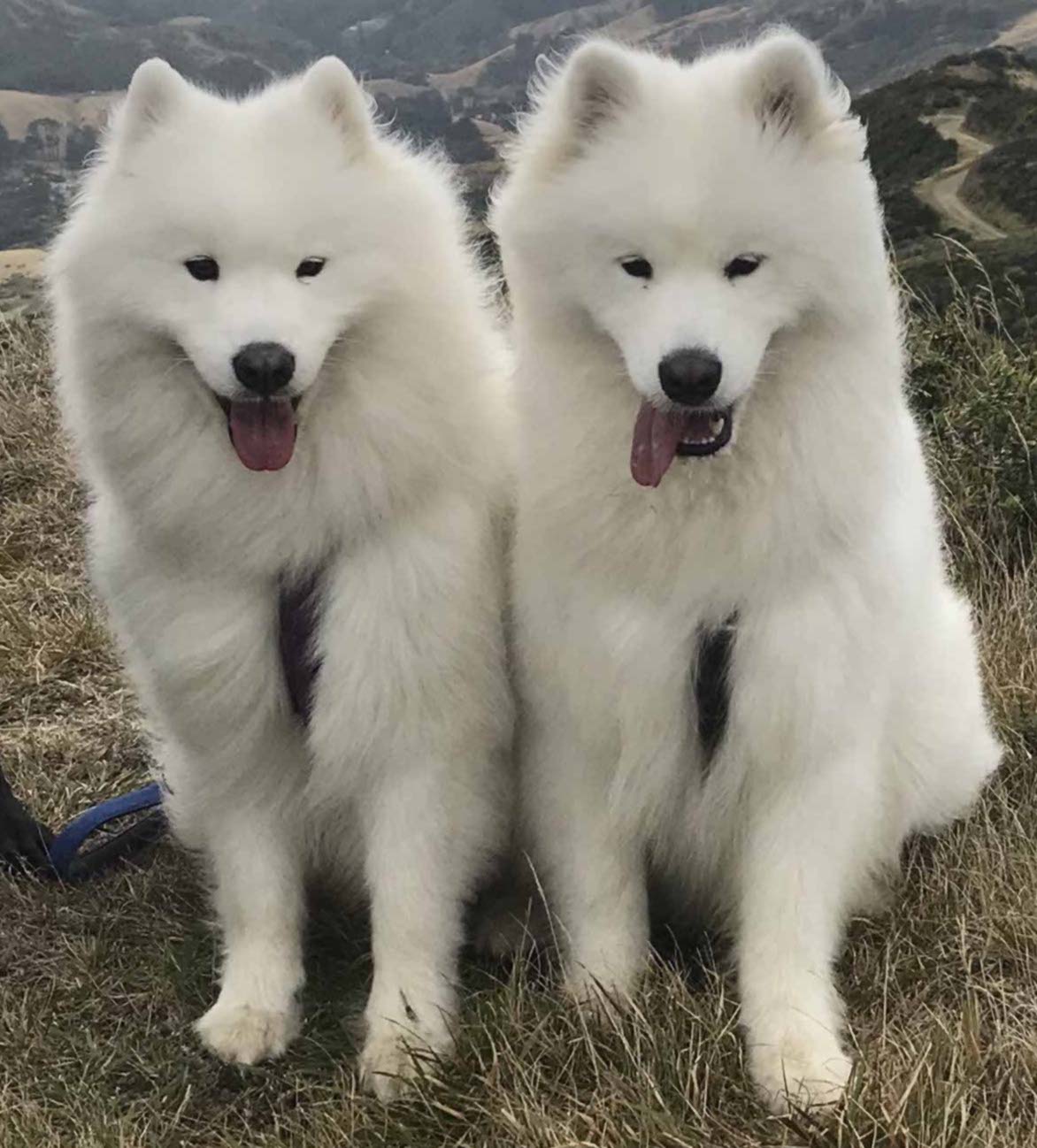
SAMOYED HISTORY
The Samoyed comes from the northeastern regions of Siberia where a nomadic tribe called Samoyedes lived; hence, the breed's name. The dogs, descended from the Spitz family, were used to protect and drive the herds of reindeer from one place to another as the tribe travelled. They were also used as freight and pack dogs. It wasn't until the late 1800's that a fur-trader discovered the breed and brought some back to England in 1889. Development of the breed took place shortly thereafter, and the breed's popularity grew.
The Myths and The Mystique Surrounding Early Samoyeds and Their Owners
An Ancient Breed with Herding In Its Blood
(Photos showing articles in June 1993 NZKC Gazette complied by Sandra and Lauren. Given permission to use.)
“Strains of Influence”, by Lauren V de C James, The New Zealand Samoyed Supplement, NZ Kennel Gazette – June 1993
“The Kalina Story”, by Yvonne Sydenham-Clarke, The New Zealand Samoyed Supplement, NZ Kennel Gazette – June 1993
“Early Show Ring Days”, by Sandra Stewart and Val Auckram, The New Zealand Samoyed Supplement, NZ Kennel Gazette – June 1993
“The Domination of Imports”, by Sandra Stewart, The New Zealand Samoyed Supplement, NZ Kennel Gazette – June 1993
“Top Broods”, by Sandra Stewart, The New Zealand Samoyed Supplement, NZ Kennel Gazette – June 1993
“Top Studs”, by Sandra Stewart, The New Zealand Samoyed Supplement, NZ Kennel Gazette – June 1993
“New Zealand’s Top Kennels”, by Sandra Stewart, The New Zealand Samoyed Supplement, NZ Kennel Gazette – June 1993
“Grand Champion Samways Summer Knight”, by Gary and Lyn Carleton, The New Zealand Samoyed Supplement, NZ Kennel Gazette – June 1993
“Aust Ch & NZ Gr Ch Kimchatka The Godfather”, by Eli Maitland, The New Zealand Samoyed Supplement, NZ Kennel Gazette – June 1993
The Myths and The Mystique Surrounding Early Samoyeds and Their Owners
[Reprinted from Sleigh Courier June 2002, Sept 2002 by kind permission of the author, Helen Gabb, Sever Samoyeds.]
Lynne (Barr) asked if I would write an article on the "Early Samoyeds" for this edition. In deciding where to begin I took a little liberty with this all encompassing subject choosing a little on what is known, both fact and myth, of the early Samoyeds - and mostly only of those Samoyeds who reached the Southern Hemisphere.
When researching the history of our breed it takes very little time to realize that a great deal of "mythology" and contradicting "facts" have been spread far and wide over the years regarding those early Antarctic expedition Samoyeds and their owners too.
Shortly before her death in South Africa (circa 1983) the late Mrs Ivy Kilburn-Morris (nee Kilburn-Scott), who played an essential and important part in her mother's development of the English Samoyed, wrote to breed aficionado Irene Rowe, in Zimbabwe, describing her early days with the breed.
A small, interesting and informative article based on this letter was later published in a Samoyed Club of America Bulletin, in which Ivy said the "Samoyed (or Siberian Reindeer Herd Dog) is one of the purest and most beautiful of the 30 different types of Arctic dogs. It is the domestic dog of the Samoyed people and is used for herding reindeer, hunting polar bear and guarding the "chooms" (portable tent-like homes). "A graceful, medium sized dog, average height at shoulders 21 to 22 inches (23 permissible); weight 45 to 55 lbs." "The Samoyed body build is made on the lines of the Border Collie."
From this we can determine that even back in the early 1900's the "taller" Samoyed dog was sometimes a factor in the breed even from the beginning. And, therefore there have always been some smaller and some larger Samoyeds. We can also ascertain that our dogs today are generally carrying a little more weight then their predecessors. There are definitely some today that could never be described as "border collie-like in construction" - but there are still others who are certainly not too far removed from this description of a medium sized dog either.
Mrs Kilburn-Morris emphatically stated in her article that "Sir Ernest Shackleton DID NOT use pure Samoyeds on his expeditions for sledging; and neither did Carsten Borchgrevink". One now wonders if this was written from actual ignorance of the true facts. Or dare I say it, to perhaps discredit those early Samoyeds, who had for a number of generations been bred in the Southern Hemisphere (particularly in New Zealand), those who remained strong and typical without having any early so called "English Samoyed" influences reach them.
It is quite clear from the photographs published in "The Samoyed - (New Zealand)" by Pearl Wilson and Val Auckram and in "The Complete Samoyed" by Bob and Dolly Ward that both polar explorers most certainly did have some exceptionally typical purebred Samoyeds amongst their various sledge dogs.
As well, Australian Louis Bernacchi, writing of the Newnes-Borchgrevink (SS Southern Cross Expedition 1899/1900) in his book "To The South Polar Regions" said "dogs were procured from the Samoyeds in the North of Siberia and were the first dogs ever introduced in Antarctic exploration."
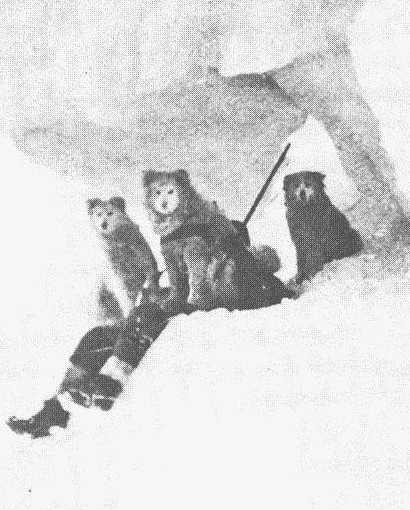
Borchgrevink and dogs on an ice ledge in the Antarctic.
Mr R H Trail, son of the Stewart Island warden, Mr A W Traill, writing of the return of the Borchgrevink Expedition (1899/1900) sledge dogs from the Antarctic for the Wilson/Auckram book said "because of quarantine restriction the sledge dogs were to be destroyed. My father was so appalled at this he got permission to have them landed on Native Island and undertook to look after them until they could be used by some future expedition.
They were a mixed lot, mostly probably Huskies with perhaps a Russian Collie, and a sprinkling of white Samoyedes." "Later, having difficulty in feeding the dogs once the stores of biscuits had been used and realizing that another expedition had gone south without knowing about these dogs my father reluctantly destroyed all except the white Samoyedes. These are the ones from which he bred and sold some pups."
Later "these animals (with the exception of one bitch which was retained as a pet for my sister) were collected and taken south by Shackleton's expedition. Sir E H Shackleton wrote in his "The Heart Of The Antarctic" of his 1907/1909 Expedition "I knew that a breeder in Stewart Island, New Zealand, had dogs descended from the Siberian dogs used on the Newnes/Borchgrevink expedition. I cabled him to supply as many as he could up to forty. He was only able to let me have nine, but this team proved quite sufficient for the purpose of the expedition, as the arrival of pups brought the number up to twenty-two during the course of the work in the South."
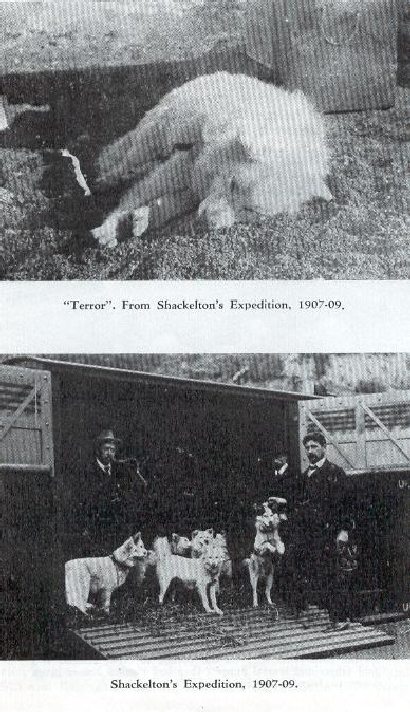
The dogs from the Shackelton Expedition of 1907/1909 were most certainly purebred Samoyeds as the old archival photographs and the early movies taken on the expedition clearly show.
For those who may have seen the recent excellent two part BBC TV series "Shackelton" - there are numbers of instances in that series where either the old original lantern slides or snatches from the very old stilted original expedition movies are used.
These have obviously been obtained from Antarctic archives. They too quite clearly show a sprinkling of obviously purebred Samoyed dogs working in harness or lazing about the ice or on board ship.
Ernest Kilburn-Scott. a breed founder in the UK, acquired from an Australian Sydney Zoo the Samoyed he named Antarctic Buck. Many claim this dog was descended from dogs taken south on the Newnes/Borchgrevink expedition in 1899/1900. However, Ivy Kilburn-Morris, Ernest's daughter, wrote in her letter that "in 1906 my father found a pure bred Samoyed chained up in Sydney Zoo, where it had been for six years. The dog had NO history behind it. In 1908 my father returned to England (after his lecture tour at Sydney University) taking the dog with him. After quarantine and his first show, he died of distemper, and only five of his puppies survived the epidemic."
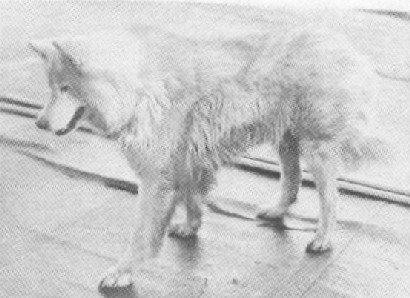
Antarctic Buck onboard ship - enroute to England.
Clearly from what Ivy wrote I think we must accept that Antarctic Buck's origins are totally unknown. He could have arrived in Sydney - an extremely busy seaport then, as it is today, by many varied means and from numerous immediate origins other than his breed's homeland of Siberia.
It is interesting to ponder the many myths that have been written about him. One tendered to me, which most certainly surprised me several years ago, by a noted Dutch Samoyed breed historian was the claim that Antarctic Buck was actually born in Hobart, Tasmania. When I questioned this statement by asking for references to corroborate the statement it was withdrawn - although quite clearly at the time of originally writing my correspondent truly believed this "new for me" claim to be true
Various publications have over the years included numerous "myths" regarding Antarctic Buck's origins. W Lavallin-Puxley wrote in "Samoyeds - 1934" that Antarctic Buck had been "employed on the NewnesBorchgrevink ss Southern Cross Expedition 1899/1900 to the South Pole" - (another myth included there too as that expedition didn't make it quite that far south.)
The UK Samoyed Association book "The Samoyed" 1961 Edition claimed that "Antarctic Buck and Trip came from the Borchgrevink Expedition (1908/1909)" - clearly an error as Antarctic Buck was discovered in the Sydney Zoo in 1906 where it is known that he had lived for the previous six years.
It is interesting to note that the 1971 edition of the same book, perhaps more accurate, corrects the earlier edition's claim by stating "Antarctic Buck and Trip, came from, or descended from, early Antarctic expeditions."
Another furphy that appeared in Joan McDonald Brearley's book "This Is the Samoyed" claimed that "Antarctic Buck one of Kilburn-Scott's notable dogs was purchased after the Borchgrevinks expedition" noting that "the dog was born on ship on the way to the Antarctic"
Bob and Dolly Ward wrote in their book "The Complete Samoyed," 1st edition, that Antarctic Buck came from the "Norwegian Carsten Borchgrevink's English expedition to the Antarctic in 1904."
The 2nd edition of their book claimed "Carsten Borchgrevink, a Norwegian who lived in Australia, led an English Expedition to the Antarctic Feb 17 1899 - February 2 1900". (An important difference???). they also wrote there that "two dogs from his pack had tremendous impact on the breed. The greatest was Antarctic Buck..."
I didn't purchase the third edition of their book so I do not known if the Ward's made further changes to "their Antarctic Buck history" when compared to their 2nd edition claim?
Another myth, since repeated by other author's, which also appeared in the 1st edition of the Ward's "The Complete Samoyed" was that the tragically flawed Polar explorer Robert Falcon Scott was the brother of Ernest Kilburn-Scott. This was amended to read "friend of Ernest" in the 2nd edition.
Ivy Kilburn-Morris wrote in her previously mentioned letter "Captain Robert Falcon Scott, a friend of my father, never intended to use any breed of dog on his expedition. He was presented with four of our dogs as a novelty on board whilst his ship was in dock in London. Unfortunately, three of these died of distemper and one fell overboard."
Yet R F Scott wrote in his "The Voyage of Discovery (1901/1903)" we now have three litters of puppies in various stages of development. "Vinka", Armitage's pet Samoyede, has four which were born a month ago and are now capable of snarling and snapping on their own account."
Did these Samoyeds originate from a source other than the Kilburn-Scott's?
From this expedition "Capt. Scott presented five Samoyeds (3 bitches and 2 dogs) to the Wellington Zoo. Later the Zoo imported further Samoyeds from Denmark (in 1911) and England (1915 and later). The last Wellington Zoo importation being made in 1934, their last litter was whelped in December, 1941.
Prior to 1942 the Zoo Samoyeds could have no influence on the breed in New Zealand; but later "Scotty" was bred from. It is probable that one or two others from about the same time (which are listed in the pedigree section of the Wilson/Auckram "The Samoyed New Zealand" book) were also purchased from the Zoo.
Another "famous" Samoyed to make (his/her?) mark in the Southern Hemisphere was "Etah" who was the Norwegian Roald Amundsen's lead dog on his December 14th, 1911 arrival at the South Pole.
Amundsen is said to have taken 52 dogs (out of his 97) and 4 sledges on his record breaking run to beat Capt Robert Falcon Scott in being the first person to reach the South Pole. "As planned his expedition returned having conquered the Pole with four men, 1 sledge and only 12 surviving dogs." The round trip, taking 99 days, covered 1,860 miles. The first animal to cross over the Pole is said to have been the all white Samoyed lead dog "Etah".
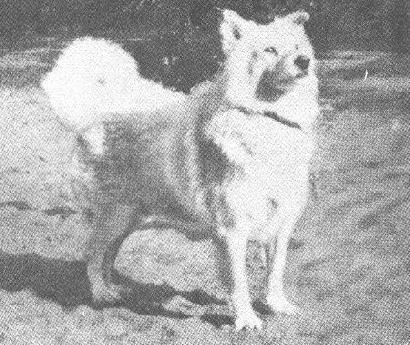
Etah at 11 years of age.
Yet another myth I hadn't previously recognized unearthed itself when I was checking facts for this article - I had always assumed "Etah" to have been a male - being referred to as "he" in several articles. But, I discovered in the detailed history segment written by Joan Mcdonald Brearley in her 1975 TFH Publication "This Is The Samoyed" that it is stated that "Etah earned the title of being the first known dog to get to the South Pole. She later became the cherished pet of the Princess de Montyglyon, Countess Mercy d'Argenteau and was one of the few expedition dogs to live out a long and full life, fully appreciated for her worthy achievements. (Quite clearly a change of sex there!)
The Princess de Montyglyon herself had a very romantic career in her ownership of some of the early Samoyeds - acquiring her first "Moustan" a Russian Champion, from the Grand Duke Nicholas, brother of the Russian Czar (that is another story for another time!). "Moustan's" son Ch de Witte of Argenteau became the first American Samoyed Champion in 1907.
The Princess dedicated her memoirs to her Samoyed - the famous "Etah". Does anybody have a copy ? My guess from her extensive travels and her many dog related activities in various parts of the world it would certainly make amazingly fascinating reading.
Now to return to Antarctic Buck and the five years (1904-08) when he remained in the Sydney Zoo after Ernest Kilburn-Scott first discovered him there in 1904.
These years also provide some interesting insights into the life and work of Ernest Kilburn Scott. I wondered why he would be visiting Sydney twice in what for the times seemed a relatively short period. I obtained a reader's ticket for the Sydney Mitchell Library Archives and together with Kylie Bourke (Tamkobe Samoyeds - now a USA resident) we research amongst other things the records from the old Moore Park, Sydney Zoo.
Whilst we discovered only a little of the dog that we assumed must be Antarctic Buck we did discover a great deal about Ernest Kilburn-Scott's reasons for being in Sydney. It is probable that he remained here in Australia throughout all of those years ie (1904-1909). Several publications we had read had claimed Ernest was a "timber merchant". Another myth perhaps ?
Possibly taking liberty with his writing of being in Archangel in 1899 a passenger on board the SS Sunlight and while timber was being loaded visiting the nearby Samoyed encampment where he purchased the fat puppy Samoyed "Sabarka".
In fact, we did discover much about Ernest that somehow has managed to become "lost" to the Samoyed history of the past century. There in the Mitchell Library are historical articles that Ernest had written of various early dignitaries in Sydney in his capacity of President of the Yorkshire Society.
We discovered that he had been responsible for electrifying Sydney University. We found his various detailed plans for hydroelectric schemes in New South Wales. We wondered could it be possible that similar schemes might also have been his reason for being in Archangel when he purchased "Sabarka"? We found his Sydney office and home phone numbers and his addresses for those years in Post Office records of the day.
For the later years 1908/1909 we also found phone numbers and an address for his wife Clara Kilburn-Scott who presumably bought the family out to Australia to live for those years. But, we still had not discovered why Ernest spent so long living in Sydney.
Later, visiting Sydney to meet a Samoyed owning friend, Mrs Beth Taylor, then working for the Royal Australian Historical Society as a Librarian. And waiting for her to finish her work I browsed through the book "Australia's First - A History of the University of Sydney - Volume 1 - 1850-1939".
There I discovered on pages 253-254 the facts of the "lecture tour" in Sydney. The University's "Russell Gift" - a highly prestigious and sought after award that is still in existence today had enabled the University to appoint Ernest, from the best of world-wide applicants, to be the University's first Electrical Engineering lecturer (an engineering facet then in its infancy).
Prior to this Ernest had been a lecturer at the Northhampton Institute in Clerkenwell, England. Ernest took up his Sydney post in 1904 and resigned in 1909. It was surprising to discover that Kilburn-Scott was actually in Australia for such an extended period. It is unlikely that he returned to England either during any of this period - the long University summer break would have not allowed him sufficient time to travel there and back via the steam ship transport of the day.
One wonders how the "English Samoyed" might have developed if the Kilburn-Scott's had remained in Sydney. Would they have perhaps eventually looked to the New Zealand Expedition Samoyeds progeny to increase their bloodlines?
Mr Geoff Grounds, later attempting to follow up the "Australian" information regarding Ernest’s life, was unable to find any details of Ernest in the UK after 1916. Fearing that Ernest perhaps may have passed away as a casualty of WW1, or of other causes, was surprised when the last remaining Kilburn-Scott daughter (Mrs Enid Bronson) was able to advise that her father had actually migrated, in 1916, to the USA, leaving Clara and her daughter/s in England to carry on the Farningham Samoyeds.
We must therefore now attribute a great deal more to Clara and her expertise in the development of her early Samoyeds than the history that had been passed down to us led us to believe.
It is interesting to ponder too how Samoyeds worldwide would have developed without the input of the Antarctic Buck genes. We know that two Samoyeds were in the Sydney Zoo during part of Ernest's period in Sydney and wonder what happened with the other one.
Zoo records do not record either Samoyed's disposal, as they usually did with other creatures. Good records of deaths, births and sales to individuals or "swops" with other Zoos are still to be found from the Zoo’s yearly population census of the period. But, the Samoyedes, on paper at least, just disappeared.
"Ambrose" another previously unknown expedition Samoyed who was given to Shackleton Expedition Geologist Professor Edgeworth David on his return to Sydney. (It is probable too that Professor Edgeworth David would have known Ernest Kilburn Scott, as despite being absent in the Antarctic during part of Ernest's appointment he was Sydney University's Professor of Geology throughout that period.)
A photograph and description of "Ambrose", who sadly succumbed to distemper, as did Antarctic Buck, appears in his daughter - Mary Edgeworth David's book "Passages Of Time".
Mary's description of the long ago expedition dog could so very easily fit one of our own modern day more pampered Samoyed breed, viz:- "Soon after the return of the Shackelton expedition my father was presented with one of its sledge dogs. Lineally, I believe, this dog, Ambrose, like his fellows, was descended from Siberian wolves. He was certainly the most charming and good natured wolf that one could possibly imagine. Little Red Ridinghood's grandmother would have fallen for him in more ways than one. We all loved him. He was very handsome - fluffy and cream-colored, with intelligent brown eyes.
Taking him for walks was a strenuous business, as he pulled at his leash with the same vigor that he applied to his sledge harness.
When we took him up the mountains to our Woodford home, we tethered him under a tree the first night, but he had never come across trees before, and couldn't sleep for the rustling of their leaves. After that we allowed him to sleep where he chose.
He commandeered a sofa on the front verandah, and to make a really cosy bed collected half a dozen cushions from the sitting room, and arranged them in a neat heap on his sofa. There he slept really comfortably. He was so happy and pleased with himself about this arrangement that we hadn't the heart to disturb him.
Besides, he carried the cushions very carefully, and nothing was damaged. Ambrose, alas! died of distemper not long after he came to live with us. Coming from the germ-free Antarctic, he was an easy prey to microbes."
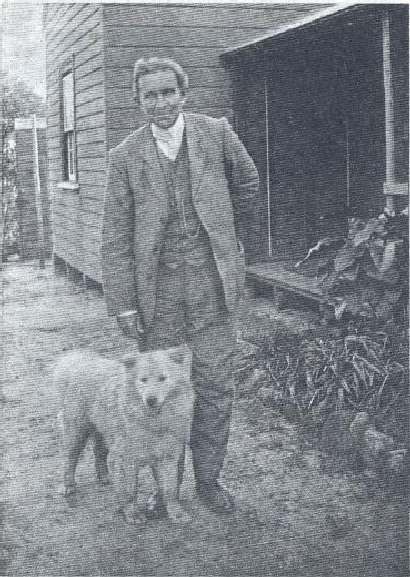
Professor Edgeworth David in 1910, with Ambrose, the sledge-dog lineally descendant from the Siberian wolf. After the return of the Shackleton Antarctic expedition, Professor David was presented with Ambrose as a token of appreciation of his services. Coming from germ-free Antarctica, the dog died of distemper not long after arriving in Australia.
My own first Samoyed Aust Ch Iceland White Crystal CD sparked my interest in early Samoyed history although 2/4's English breeding - 1/4 on her dam's line traced back to the dockside matings in New Zealand with sires from the Polar Expedition Samoyeds and to various expedition Samoyeds themselves
She descended from the males Coona - from Shackleton's Ship "Nimrod", and from Nova from Captain Scott's ship "Terra Nova", from Flossie born in the Antarctic (sired by Vero out of Light), from Marco and Sunbeam both expedition Samoyeds. She also descended from NZ Ch Prince Aututaki (Imp) whose sire and dam were believed to have been Omar and Princess Olga.
"Aututaki" himself was purchased from the mate of the Newfoundland schooner "Forest Home" when the ship was seized in Wanganui Harbour for non payment of debts. He was believed to have been Canadian - but that could not be authenticated."
Sadly we no longer have any of these lines left in our own kennel. But, I do know that one or two others here in Australia and probably a selected few in New Zealand too, can still trace their Samoyed's pedigree back to similar dockside matings with expedition Samoyeds or to expedition dogs themselves. They remain, as they always have, a well-kept secret from the rest of the Samoyed world.
One wonders if the New Zealand descendants from the Southern Expedition Samoyeds, who presumably may also have carried similar bloodlines to the esteemed Antarctic Buck, had been recognised by Samoyed owners around the world would they too have had significant effects on the development of the "English Samoyed".
Perhaps if they had been then recognised and given their due Mrs Ivy Kilburn-Morris would not have inaccurately perpetuated the myth that "Sir Ernest Shackleton did not use pure Samoyeds on his expedition for sledging and neither did Borchgrevink."
I learnt that no matter how esteemed an author may be we should never believe what we read without first obtaining corroborating proof from other reliable sources. Sometimes it can be a surprise to see subtle and sometimes not so subtle mistakes in otherwise very learned publications.
I am still hoping one day to visit the University of Sydney Library Archives. One never knows what may be lurking waiting there too.
An Archives Librarian did very proudly tell me, some years ago, when I inquired, that papers from Ernest Kilburn-Scott (the prestigious Russell Gift Endowee) are on file there, and that the archives has an enormous collection of Prof Edgeworth David's (the owner of Ambrose) writings and his Polar artifacts etc. One day maybe......?
References:
- The Samoyed (New Zealand) - 2nd Edition 1966 (Cliff Press Hastings NZ) - Pearl M Wilson & Valerie E P Auckram
- The Samoyed - (The Sam Assoc UK) - 3rd Edition 1961
- The Samoyed - (The Sam Assoc UK) - 4th Edition 1971
- Samoyeds (1934) - (Publisher Williams & Norgate Ltd) - W Lavallin Puxley
- The Complete Samoyed - (Howell Book House) - 1971 - Robert H and Dolly Ward
- The New Complete Samoyed - (Howell Book House) - 1985 - Robert H and Dolly Ward
- This Is The Samoyed - (TFH Publications) - 1975 - Joan McDonald Brearley
- Passages Of Time - (University of Queensland Press 1975) - Mary Edgeworth David
- Australia's First - A History of the University Of Sydney Vol 1 - 1850-1939 ( Turney Bygate & Chippendale)
From the List of Animals in the Zoological Gardens Moore Park:
- 31st December 1904 - 1 Canis familiaris - Esquimax Dog " (an early name for Samoyedes)
- "31st December 1905 - 1 Canis familiaris - Sayomede Dog " (note spelling?)
- "31st December 1906 - 1 Canis familiaris - Samogede Dog" (change of spelling??)
- "31st December 1907 - 2 Canis familiaris - Samogede Dogs"
- 31st December 1908 - No longer any Samoyeds listed and also no record of the disposal of the previous year's 2 dogs listed.
Helen Gabb
Sever Samoyeds
Early Days
The Samoyed is one of the very early species of the Canis Familiaris Intermedius group, said to date back to about 6000 BC.
The specific area of origin will probably be forever in conjecture, some assigning it to the territory from the White Sea to the Yenisey River, others to the tundra region between the White Sea and the Kara Sea.
The nomadic Samoyede people were a large unit of clans who lived by hunting and fishing, inter-married, shared hunting rights, pastures and livestock. For the greater part of the year they were scattered singly or in small groups, coming together in the summer. Their dogs were used mainly for reindeer herding and polar bear hunting, were very domesticated and lived closely with the people. Their moulting coats were a valuable contribution towards warm clothing, and at times the dogs were used to eke out the food supply.
Samoyeds are known to have been used as sled dogs in Siberia as early as 1870 by Nordenskiold, and on Arctic expeditions by Nansen (1893-94), Jackson Harmsworth (1894) and later the Duke of Abruzzi and others. It is recorded that over a 100 miles have been covered in one day by three dogs with full sledge - an astonishing record when the rough state of the going is considered, for snow does not lie like smooth hard icing.
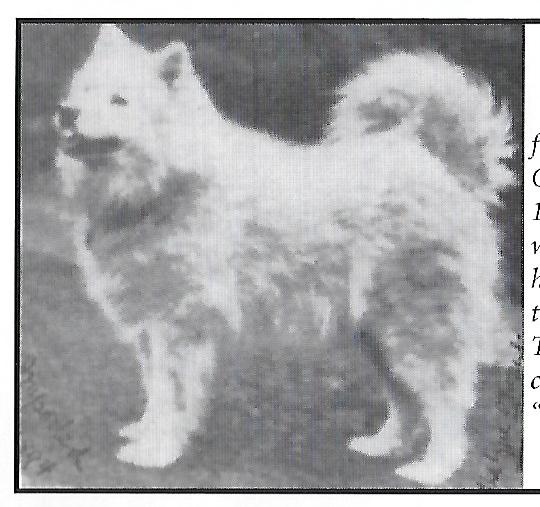
Samoyed Dog imported from western Siberia by Capt. Labourn Popham in 1894 Unfortunately never welded into the breed, note how closely he matches today's breed Standard. The hand-written comment on the photo is: "They type I want."
In 1889 Mr Kilburn-Scott, a passenger on the SS Sunlight loading timber at Archangel on the White Sea, visited, with a Russian friend, a Samoyede encampment on the nearby tundra. Many dogs were running about and Mr Kilburn-Scott picked up a particularly attractive and intelligent-looking plump puppy and asked if he might buy it to take back as a present for his wife. This was agreed to with pleasure.
"Sarbarka" was exhibited in 1894 at Birmingham in the Foreign Dog class. He aroused keen interest and eventually Mr Kilburn Scott, no doubt tired of being asked "What breed is he?" decided that Sarbarka should adopt the name of his people. Later Mr Kilburn Scott imported "Whitey Petchora" from a ship trading in the White Sea, and further dogs were imported by others or taken back to England by subsequent expeditions.
Books on the early history of the Samoyed in England are peppered with the names of aristocracy - duchesses, countesses, the Honourable Mrs This, the Lady That, Captains, Majors, Colonels. And in 1902 the pure-white "Jacko" was presented to Queen Alexandra by Major Jackson.
In 1906 the first Samoyed in the United States, the white "Moustan", was registered. Moustan had been a gift from the Grand Duke Nicholas of Russia to the Princess de Monyglyon - born a Belgian Countess, a Duchess by marriage, mother of a Marquis, herself an hereditary Princess of the Holy Roman Empire - and married to a lion tamer!
By to day's standards, although still obviously an aristocratic dog the breed seems to have slid somewhat down the social scale!
There was considerable variety of colour in the early imports. Authorities maintain that white dogs procured from northern Siberia between the White and Kara Seas were the "true Samoyed" and that those introduced from Russia were mostly coloured or, if themselves white, produced coloureds. It seems that dogs from several areas were imported into England and the combination caused problems in breeding the white, cream or biscuit preferred both by breeders and the general public.
In 1909 Mr Kilburn-Smith founded the Samoyede Club and a breed standard was drawn up. In drafting the original standard, officials of the Samoyede Club took into consideration direct imports and also those resulting from generations of English-bred dogs.
Meanwhile, back in New Zealand, coincidentally, the breed was also being established - not by expending time, effort an money, but because Samoyeds virtually arrived at our back door and demanded to be let in!
In his book "To the South Polar Regions", Louis Bernacchi covers the 1899-1900 Newnes-Borchgrevink expedition in the SS Southern Cross: "The sickness was aggravated by the intense heat and the appalling effluvium arising from the 90 Siberian sledge-dogs we had on deck. These dogs were
procured from the Samoyedes in the North of Siberia and were the first dogs ever introduced in Antarctic exploration".
C E Borchgrevink's book, "First on the Antarctic Continent", refers to the return trip of that expedition: "Later we steamed round Halfmoon Bay, where a little settlement of houses is situated, called Oban. During our stay there 1 made arrangements for landing the sledge-dogs on Native Island, a small island adjacent to Stewart Island, providing I should could obtain the necessary permission from the New Zealand Government."
That permission was granted by the Honourable Mr Ward, later Prime Minister, Sir Joseph Ward, but then Minister of Internal Affairs. A breeding pair of Samoyeds was given to Mr Ward by Captain Robert Scott about 1901 and, in 1902, he became the first registered breeder of "Esquimaux" - an early name for the breed in this country.
During 1965 I had personal correspondence with the son of the Native Island warden, Mr A W Traill, who had cared for the dogs off-loaded from the 1899-1900 expedition. Mr R H Traill wrote me that although he was only eight years of age at the time, he remembered the Southern Cross anchoring off Ringaringa Point opposite their house and Mr Borchgrevink catching the sailing oyster cutter, Ruruhau, to Bluff to send word of the expedition's return, while the sailing master, Captain Yensen, and some of the officers, including the Lapland handlers of the sledge-dog teams, spent an evening at the Traill house.
Mr R H Traill wrote: "Because of the quarantine regulations the sledge dogs were to be destroyed. My father was so appalled at this he got permission to have them landed on Native Island and undertook to look after them until they could be used by some future expedition. Later they were brought to Ringaringa and enclosed in yards. We used them to sledge firewood and they enjoyed the exercise."
At a later stage Mr Traill Snr bred from the white Samoyeds and sold some pups. Some of these were registered with the New Zealand Kennel Club and used for breeding. Other dogs were later collected and taken South by Shackleton's Expedition.
"The Heart of the Antarctic" written by E H Shackleton, refers to these dogs in connection with his 1907-09 Expedition: "I knew that a breeder in Stewart Island, New Zealand, had dogs descended from the Siberian dogs used on the Newnes-Borchgrevink expedition and I cabled him to supply as many as he could, up to 40. He was only able to let me have nine, but his team proved quite sufficient for the purposes of the expedition, as the arrival of pups brought the number up to 22 during the course of the work in the South."
Between these two expeditions, Captain Robert F Scott also tripped South (1901-03) with 20 dogs obtained from the Samoyede tribes in Northern Siberia. At one point in his book "The Voyage of the Discovery" he refers to "Vincka, Armitage's pet Samoyede" having a month-old litter of four.
From this expedition Captain Scott presented three female and two male Samoyeds to the Wellington Zoo and later the zoo imported further Samoyeds from Denmark (1911) and England (1915 and later), making the last importation in 1934. In December 1941, after the last zoo-bred litter had been whelped, the Samoyed section was closed and young dogs and puppies sold to the public. Although none had been registered with NZKC, a few of these dogs were later used for breeding.
Herbert G Ponting's book "The Great White South" covers the British Antarctic Expedition of 1910-1913. He mentions the fact that "someone in England" - in fact it was Mrand Mrs Kilburn-Scott - "had presented Captain Scott with three English-bred Samoyedes, who felt that these pretty exotics were quite unfit for such arduous work which lay ahead. "One of the Samoyeds died on the journey and several puppies they had produced were given away to friends of Captain Scott in Christchurch".
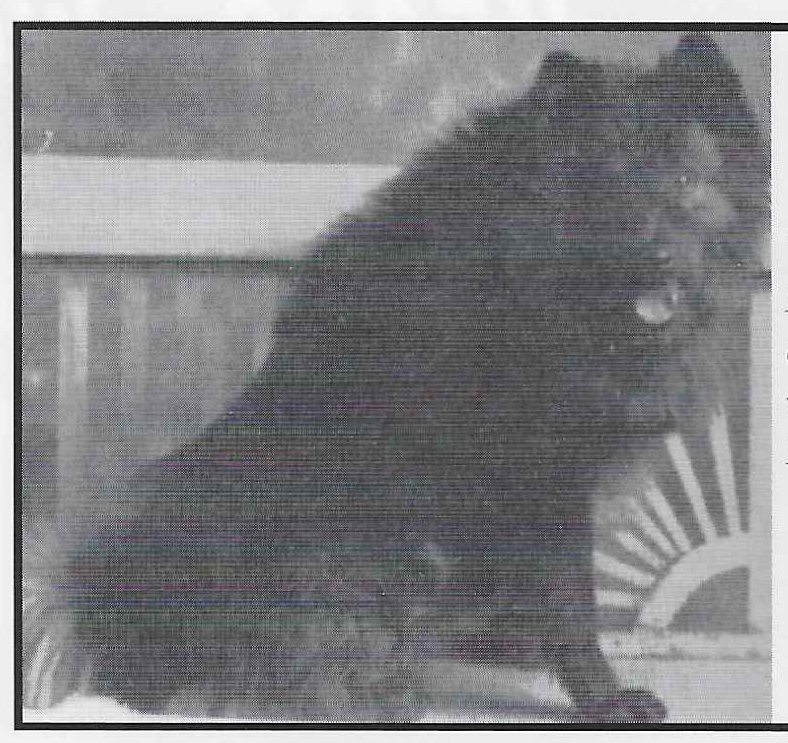
The black Samoyed "Pedro"' owned by Mrs Cammack A Son of Peter The Great, he was bred with early Kilburn-Scott bitches
So there we were in the lucky seat again - this time reaping the benefits of English breeders (unknown to them) - and the dogs a gift to boot! One of these bitches arrived with the name of "Nova" and appears in New Zealand pedigrees, and another "Lady Scott" was also bred from several times.
Admiral Richard E Byrd was the last Antarctic explorer to be connected with the Samoyed breed and is also the registered breeder of "Snow Queen", whelped in 1947, left in this country and registered with the NZKC in 1953.
From the first registration in 1903 the breed was known as "Esquimaux" and this intermingled with "Eskimos" and "Samoyede" for many years. But by 1924 the name "Samoyed" seems to have become firmly established.
By Val Auckram
(co-author of THE SAMOYED (New Zealand) Still the breed bible 45 Years!)
(Reprinted from 1993 Samoyed Supplement)
New Zealand Kennel Club Supplement May 2006
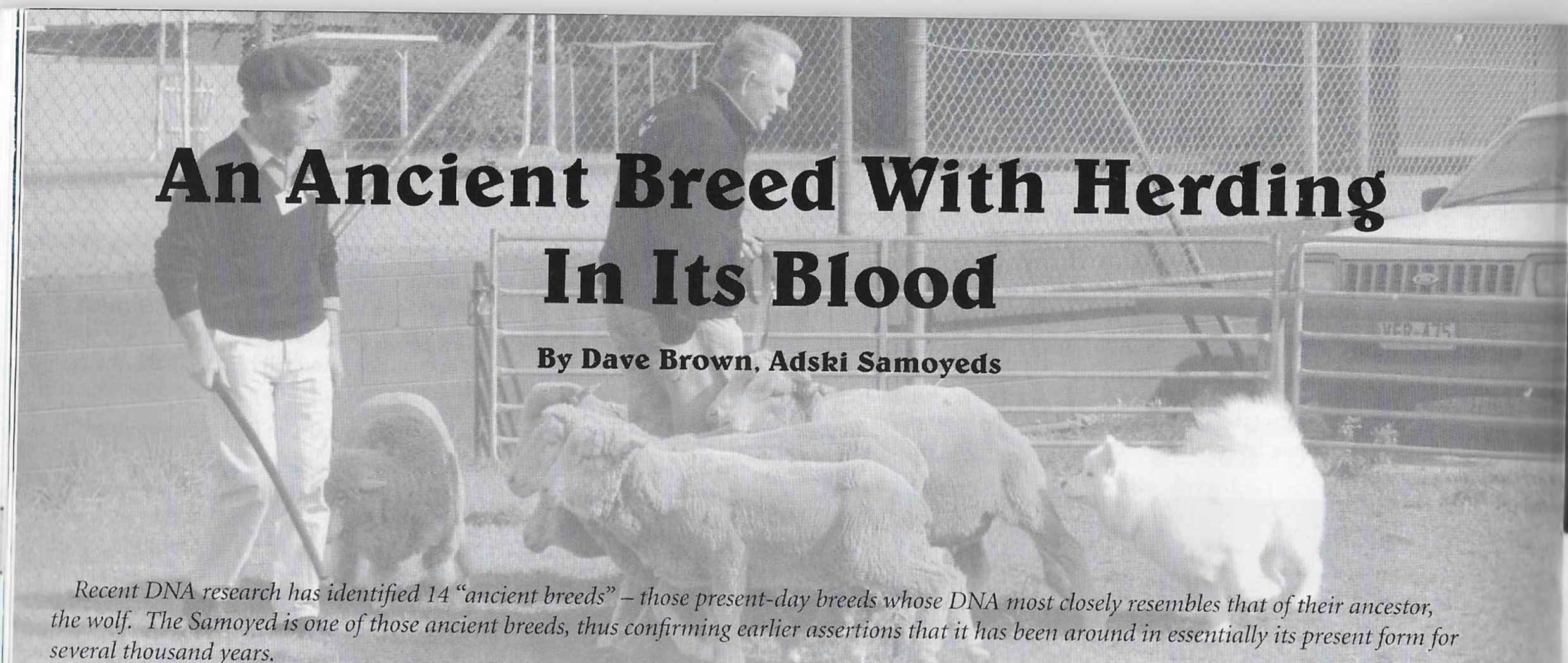
An Ancient Breed with Herding In Its Blood
Recent DNA research has identified 14 "ancient breeds" - those present-day breeds whose DNA most closely resembles that of their ancestor, the wolf. The Samoyed is one of those ancient breeds. Thus confirming earlier assertions that it has been around in essentially its present form for several thousand years.
Multi-purpose working dog
Historically, the Samoyed was a multi-purpose working dog, and one of its roles was herding reindeer. There are numerous references in the published literature on the breed to support this. Although there is conjecture as to exactly which elements of the origins of the breed were used for herding. it is clear, from contemporary experience worldwide, that the herding instinct persists to some extent in the breed today.
The Samoyed has been mentioned in travellers' accounts of Siberia for almost a 1,000 years. However, it has only been known in the Western World for a little over 100 years. Samoyeds were used by early polar explorers in both the Arctic and Antarctic. They were appreciated for their qualities of intelligence, endurance and adaptability which made them an excellent choice for the job of hauling sleds. They endured terrible hardships in extreme conditions serving man in his quest for the poles. Tales of heroic
polar exploits have led to the modern perception that the Samoyed is nothing more than a sled dog.
The reality is quite different. The breed is named after the nomadic Samoyede people - a remnant of one of the earliest tribes of Central Asia. As early mankind increased in number and separated off into families and then tribes of kinsmen, groups often drifted off or were forced away by tribal wars. The process of migration continued for thousands of years until the tribe, we now call the Samoyede people, along with their faithful dogs, eventually settled in the vast Arctic regions of north-western Siberia and
Northern Russia more than 2,000 years ago.
Somewhere along the way, tribesmen learnt to domesticate the wild caribou that they had previously hunted - the animal we now know as the reindeer. In the bleak Arctic tundra, their former agricultural skills were of no use and the tribe regressed to a primitive lifestyle revolving around their reindeer. The deer supplied most of the essentials of life. As well as providing a source of food, their hides were used for clothing, shelter, beds and rugs.
Vast herds of reindeer were required to support this lifestyle and it would not have been possible for men on foot to control and muster the herds without the Samoyed dog. Despite domestication, the reindeer and the Samoyede people still needed to travel the traditional migration routes in search of the main food source for the herds, a lichen known as reindeer moss. Vast tracts of land were grazed and the people had to move camp often. The biannual treks - north to the tundras for summer, and south to the forests for winter - could easily cover 1,000 kilometres or more.
The dogs were sometimes used for draught work, particularly for hauling small boats along river banks when the annual thaw created an immense network of rivers and streams. Generally, however, with the pulling power of herds of reindeer at their disposal, the people used the deer for the job of hauling their possessions. A dog able to herd deer would be wasted in harness, and in any case, the original mobile home, a structure of wood and reindeer hide, known as a choom, was far too heavy for a dog team.
The dogs herded, guarded, fought off wolves, caught fish and hunted bears. They occasionally hauled, but reindeer did this more efficiently.
Innate herding abilities
Despite the popular perception of a sled dog, breed aficionados have long known of its innate herding abilities. Samoyeds are "loose-eyed" herding dogs similar to Collies, Australian Shepherds, Shelties, Belgians, relying on body language and bark to control the stock. They exhibit a variety of different styles when working stock - some work very close, even shouldering or chesting the stock, while others work at a distance relying more on barking. They tend to prefer actual work to competition work, relishing the greater variety of tasks.
In the 1960s and 70s, Terry Mahedy, a sheep farmer in the Central Riverina district of NSW, used Samoyeds to herd his flock. He ran about 7,000 head of sheep on several properties which had been owned by the family for many years. His working dogs had traditionally been Kelpies, but when he was given his first Samoyed as a pet in 1965, he found that it adapted well to herding. For the following 16 years (until he sold the property), he owned several Samoyeds who all showed this natural inclination.
A few of them, he trained to work with the Kelpies. They tended to excel in different aspects of the job - one would have a natural ability to keep the mob together and would be used with the Kelpies for mustering duties - another would have an attitude and deep bark that made him ideal for yard work. One bitch, in particular, had a close affinity with lambs, looking after new-borns if the ewe needed attention after the birth. This same bitch always accompanied Terry wherever he went. When weather conditions and impassable tracks dictated the use of a horse rather than a vehicle, the Kelpies went on strike, but the Samoyed still went to work.
Terry bred and also showed his Samoyeds under kennel name, Yuskavya, with some success; a number of dogs of his breed line attaining the title of Australian Champion.
Also in the 1970s, an English breeder, Margaret Spink placed a rescue Samoyed with a farmer in the Weardale Valley at the northern end of the Pennines in Durham. He was so impressed with the herding skills of this dog that he soon ordered a puppy from Margaret. A major bonus for him was that the Samoyed was able to work through the atrocious winters whereas his sheep dogs hated the blizzards and deep snow drifts.
Again in the 70s, in an article in "Workdog" magazine (Oregon, USA), Larry Corcoran wrote:
"Some friends, here in Denver, know a sheep rancher in Wyoming who uses only Samoyeds on his ranch. Every few years, he will come to one of the local all breed shows, watch the Samoyeds in the ring, talk with the owners of the dogs he likes and make arrangements to purchase a puppy from one of them. When the puppy is ready to go, he takes him home where he and his other Samoyeds train the puppy to eventually take over for his oldest
Samoyed".
Contemporary anecdotal evidence of the Samoyed's herding heritage is abundant. There are numerous accounts of incidents where a Samoyed escape artist is eventually found rounding up the neighbour's sheep. In their book, "All About The Samoyed", Beryl and Geoff Grounds tell of an incident when a bitch that they were taking for a walk along a track in Devon decided that mustering the sheep in an adjacent field was far more fun. Pam Taylor, in her book "The Samoyed Today", tells a similar story, but this time, the "stock" were horses - prize racehorses, polo ponies and hunters.
Competitive herder from the start
Although the first recorded sheep dog trial was held in 1873, herding competition for "the dog fancy" seems to have started in the USA about 20 years ago. And Samoyeds were there at the start. In 1992, Samoyeds were the first breed outside the Herding Group to be admitted to AKC herding competition. They have been eligible for competition with the American Herding Breed Association since its inception in 1986, and for even longer with the Australian Shepherd Club of America.
In 2005, the Samoyed Club of South Australia successfully petitioned the ANKC to add the Samoyed to the list of breeds for herding competition in Australia.
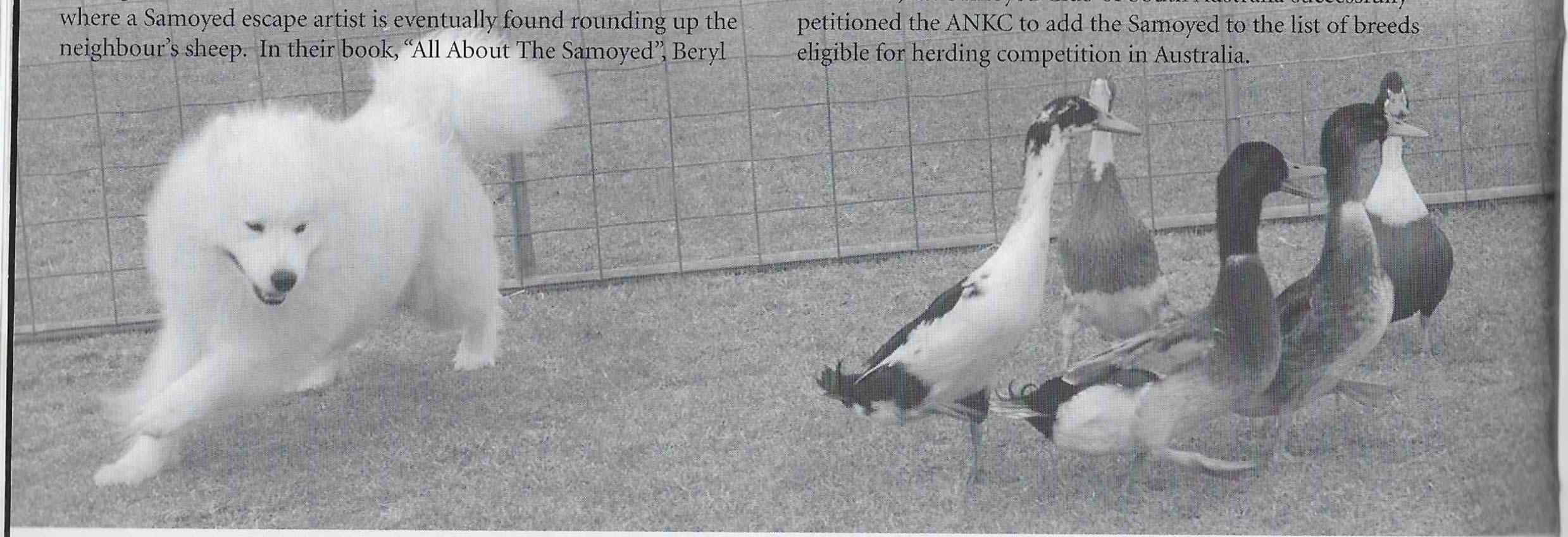
By Dave Brown, Adski Samoyeds
New Zealand Kennel Club Supplement May 2006
